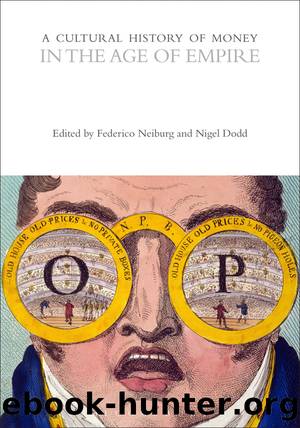A Cultural History of Money in the Age of Empire by Bloomsbury Publishing;

Author:Bloomsbury Publishing;
Language: eng
Format: epub
Publisher: Bloomsbury UK
Chapter Five
Money, Art, and Representation
âTâwas only a balloonââSeeing and Satire in the Cultural History of Money
Nicky Marsh
At the end of 2011 Virgin Money was launched as a new provider of financial services in the UK. Bearing the strapline, âVirgin Money, 40 years of better now in a bank,â the advert accompanying its launch placed the Virgin brandâs association with transport at its heart, from the futurism of âVirgin Galacticâ speeding through starry space to the nostalgia image of the Virgin hot-air balloon gently climbing over the English countryside. This balloon, condensed as a red bubble, went on to dominate the visual identity of Virgin Money (previously Virgin Direct) and appeared on its High Street shop hoardings and its credit cards, and formed the basis of its single visual logo. The profound irony of the rockâs absorption by a bubbleâVirgin Money had bought the profitable sectors of the former building society, Northern Rock, from the government after a bail-out following the first bank run in the UK in 150 yearsâseemed to provide its own unwittingly wry commentary on both the abstract, speculative nature of contemporary finance and the failure of the UK Government to respond to the dangers that these were now conclusively demonstrated as possessing.
Yet Virgin Moneyâs use of the bubble and the balloon as visual identifiers for credit was actually in keeping with the iconographic register of the financial services industry, especially in terms of its representation of personal credit and especially after the moment of crisis. Credit cards have obviously been associated with literal and metaphorical flight since their origin in the 1950sâboth the actual luxury of international travel and the imaginary luxury of being able to escape the financial constraints of oneâs immediate time and spaceâand the hot-air balloon has been repeatedly evoked in this context. It is no surprise, then, that the aftermath of the financial crisis saw financial institutions hurrying to repair the positive associations of that which David Harvey was more critically diagnosing at the time as capitalâs faltering spatial and temporal âfixâ in ways that were, appropriately, both fantastic and entirely literal (Choonara 2009: 335). The crisis had yet to reach its peak when Barclaycard launched its âWaterslideâ campaign in 2008 (to be supplemented by a rollercoaster in 2010),1 a strategy that was quickly emulated in 2009 as American Express and Lloyds TSB both launched campaigns that promoted flight and escape; the strapline of the former was âCome Fly with Me,â and the visuals included pictures of brightly colored planes or space rockets urging potential customers to âBe a Traveller not a Tourist,â2 and the latter was âFor the Journey,â and the visuals included not only hot-air balloons but trains, planes and bicycles.3 It was not only personal credit that imagined itself in such terms at this moment: an analysis of financial adverts shown during the crash noted that in their self-representations financial institutions are âshown to exist above, outside, or across and beyond the cityscapeâ and their employees are subject to an
Download
This site does not store any files on its server. We only index and link to content provided by other sites. Please contact the content providers to delete copyright contents if any and email us, we'll remove relevant links or contents immediately.
| Arts & Humanities | Health |
| Language Arts | Library Skills |
| Mathematics | Reading & Phonics |
| Science & Technology | Social Studies |
The Art of Coaching Workbook by Elena Aguilar(50307)
Trainspotting by Irvine Welsh(21162)
Twilight of the Idols With the Antichrist and Ecce Homo by Friedrich Nietzsche(18359)
Fangirl by Rainbow Rowell(8862)
Periodization Training for Sports by Tudor Bompa(7984)
Change Your Questions, Change Your Life by Marilee Adams(7450)
This Is How You Lose Her by Junot Diaz(6537)
Asking the Right Questions: A Guide to Critical Thinking by M. Neil Browne & Stuart M. Keeley(5441)
Grit by Angela Duckworth(5351)
Red Sparrow by Jason Matthews(5258)
Paper Towns by Green John(4866)
Room 212 by Kate Stewart(4815)
Ken Follett - World without end by Ken Follett(4500)
The Sports Rules Book by Human Kinetics(4127)
Housekeeping by Marilynne Robinson(4126)
Double Down (Diary of a Wimpy Kid Book 11) by Jeff Kinney(4006)
Papillon (English) by Henri Charrière(3991)
The Motorcycle Diaries by Ernesto Che Guevara(3835)
Exercise Technique Manual for Resistance Training by National Strength & Conditioning Association(3835)
